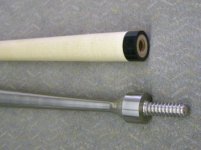Pangit
Banned
More cue speed with the light one, more inertia with the heavy one, it's a study in physics.
I have a former playing cue (23.25 oz) and changed to one of just under 19oz, Best thing I've done pool wise. I was kinda thinking like Earl Strickland, expect I wasn't using arm weight's, I was putting it in the cue.
I'm using that twenty three and a quarter for breaking now. The first thing I noticed is "how" slow it seems, but the balls dance all over the table.
I have a former playing cue (23.25 oz) and changed to one of just under 19oz, Best thing I've done pool wise. I was kinda thinking like Earl Strickland, expect I wasn't using arm weight's, I was putting it in the cue.
I'm using that twenty three and a quarter for breaking now. The first thing I noticed is "how" slow it seems, but the balls dance all over the table.


